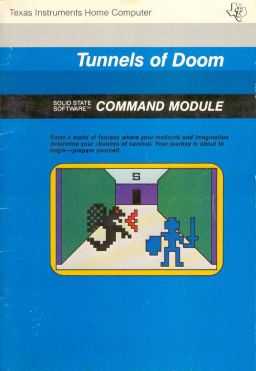Tunnels of Doom
| Tunnels of Doom | |
|---|---|
 | |
| Developer(s) | Texas Instruments |
| Publisher(s) | Texas Instruments |
| Designer(s) | Kevin Kenney |
| Composer(s) | Hank Mishkoff |
| Platform(s) | TI-99/4A |
| Release date(s) | 1982 |
| Genre(s) | Role-playing game |
| Mode(s) | Single-player |
| Distribution | ROM Cartridge, cassette tape |
Tunnels of Doom is a video game programmed by Kevin Kenney in 1982 for the TI-99/4A computer system.[1] It is consistently listed by TI-99/4A fans as one of the top games available for the system.[2][3][4] It was released in three formats: disk, cassette, and cartridge,[5] as part number PHM3042T.[6]
The game is one of the first graphical role-playing video games . Based loosely on the tabletop role-playing game Dungeons & Dragons, it is a standard dungeon crawl adventure in which a player or number of players controls the fates of 1–4 characters as they navigate through a maze of tunnels.[1][7] Despite the lack of a progressive storyline, it possesses many elements duplicated by later computer role-playing games.
Texas Instruments used the game in its marketing, citing it as entertainment software involving "strategy and logic".[8]
The features of the game include:
- Control of up to 4 characters, renamed to the players' wishes. Alternatively, four players could each control a character during the combat encounters.
- Four character classes — fighter, rogue, wizard for games involving 2–4 characters, and a "hero" class for one player games.[1]
- An encounter area that uses turn-based combat sequences.
- A dungeon crawl through various dungeon rooms in 3D, with an auto-map display.
- A display of all of the characters' health and damage which can be monitored in combat.
- A variety of monsters which grow progressively more difficult as the characters move through the dungeon.
- The ability to listen for monsters at a door before deciding to open it.
- Random encounters with monsters.[1]
- A variety of weapons and armor purchased at stores within the dungeon or picked up as treasure.
- A variety of magical treasures, which the players must figure out how to use.
- Characters that are killed remain part of the group, and will eventually come back to good health as long as at least one party member remains alive. Dead characters can still perform (or be made to perform) certain tasks including holding weapons and drinking from fountains.
- Fountains on each level. Characters can drink from fountains. The 'water' can increase or decrease a players total hit points, health, luck, etc.
- Three difficulty levels, 1-10 floors. The higher the floor and difficulty, the more powerful the creatures.
- A lost king and his orb. Find the king and his orb and return them to the surface to win. Both the king and orb have to be found within a certain number of turns, or they will be destroyed. Once the king is found, the players will be attacked in the hallways by wandering creatures. Also included is an 'easy' quest called 'Pennies and Prizes', with no monsters or traps.
The music for Tunnels of Doom was composed by Hank Mishkoff, a TI programmer who also wrote the music for the TI-99/4 Demonstration program and other early TI-99/4 programs. Mishkoff originally created the music for The Attack, an earlier program; however, TI rejected the composition for that game, using it with Tunnels of Doom instead.
In 2008, Howard Kistler of DreamCodex developed a revised version of the game, which he called Tunnels of Doom Reboot, that featured music by German composer Frank Scheffel.[9][10]
Notes
- ↑ 1.0 1.1 1.2 1.3 Tresca 2011, p. 138.
- ↑ Charles R. Grosvenor Jr., Vintage Computer Games of the Eighties, In The 80s, 2010, Retrieved September 17, 2011
- ↑ Forum member: Darthkur, Your Top Game for Each System, AtariAge Forums, Nov 25, 2009 6:14 PM, Retrieved September 17, 2011
- ↑ Forum member: Cagliostro, Your Top 5 Games, Kevin's Watch, Tue Nov 06, 2007 6:02 PM, Retrieved September 17, 2011
- ↑ 1984 complete sourcebook of personal computing, p. 272.
- ↑ The Milwaukee Journal 1984, p. Accent, 2.
- ↑ Wolf 2001.
- ↑ National Geographic 1983, p. 288.
- ↑ "Dream Codex: Tunnels of Doom Reboot". Retrieved 2010-03-10.
- ↑ "Tunnels of Doom: The Music". Retrieved 2010-03-10.
References
- Tresca, Michael J. (2011). The Evolution of Fantasy Role-Playing Games. McFarland. ISBN 9780786460090.
- Wolf, Mark J.P., ed. (2001). The Medium of the Video Game. University of Texas Press. ISBN 029279150X.
- 1984 complete sourcebook of personal computing. Bantam Bowker. 1984. ISBN 0835217655.
- The Milwaukee Journal. 14 June 1984. Missing or empty
|title=(help) - National Geographic (National Geographic Society) 163. 1983. Missing or empty
|title=(help)